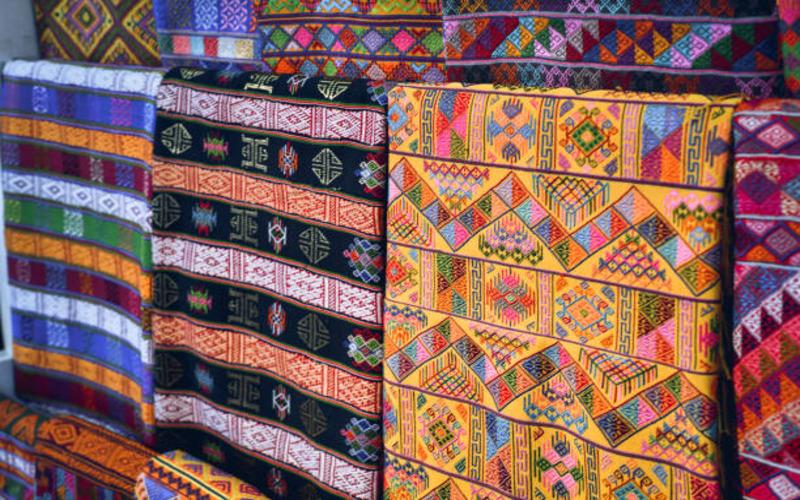The Eastern Himalayas have a small kingdom called Bhutan, famous for its pristine beauty, rich traditions, and deep spirituality. Bhutanese textiles are one of the many cultural treasures, with woolen handicrafts forming the very core of textiles. These hand-woven textiles talk of the very existence of Bhutan: its culture, beliefs, and artistry. The weaving tradition, passed down from generation to generation, is still alive in every village and valley, fashioning a beautiful carpet that symbolizes the spirit of the Bhutanese people.
Bhutan Tour provides a special opportunity to witness this artistic heritage. From the intricate patterns of silk kiras and ghos to the rhythmic clicking of the wooden looms, textiles narrate stories. The opportunity to see the artisans at work, learning ancient techniques, and trying out weaving themselves is a wonderful addition to any Bhutan tour experience! Tourists going from India availing of a Bhutan Tour Package can ensure a well-organized and deeply immersed visit into Bhutanese culture, making their experience easy and memorable.
Here are some of the Exploring the Living Art of Bhutanese Textiles.
Exploring the Living Art of Bhutanese Textiles
Bhutan is a small Himalayan kingdom nestled between India and China, known for the majestic mountains, peaceful monasteries, and very old traditions. Among its many cultural treasures, perhaps one of the most vivid and enduring is the art of Bhutanese textile. They are not merely household fabrics; they live Bhutan’s spiritual beliefs, regional identities, and societal values. Having been brought forward over generations, the country’s textile tradition is firstly a craft-and then, a sacred art form.
A Deeply Woven History
The history of textiles in Bhutan has been intimately linked to the country’s religious and royal traditions for centuries. Weaving for Bhutanese women is part of their life, especially in some eastern parts of the country like Lhuentse, Mongar, and Trashigang. This is attested by the fact that textiles have been offered for religious ceremonial uses, dowry arrangements, and even as dresses during significant rituals and festivals.
Different from most parts of the world, Bhutan has preserved both its weaving techniques and styles through isolation and strong perceptions of cultural pride. In most households, the loom is integrated into the daily life of every household member, since girls learn to weave from their mothers and grandmothers.
Rich Regional Styles and Techniques
Regions pursue different textile traditions, for an instance, the eastern part of Lhuentse where women are known for their beautiful silk weaves called kushuthara, which is a very complicated patterned fabric worn by women during very formal occasions. The western part like Haa and Paro is quite known for having simple but elegant woolen patterns used on the male traditional attire.
There are three types of loom used in Bhutan: the backstrap loom commonly used by women, the horizontal frame loom, and the vertical frame loom. The backstrap loom is an equipment that enables a woman to control the tension of the threads using her body, thus making weaving an intimate and physical process.
Textiles as a Language of Identity
Such varied techniques are: Thrima (striped weave), yathra (wool weaving from Bumthang), and mathra (coloured pattern designs). These diverse styles were reflected by the fact that it usually carries symbolic meanings that represent Buddhist motifs, nature, and protective symbols.
The most foundational textiles of Bhutan have always been a sign of identity and status. The Bhutanese national dress, gho for men and kira for women, shows these textiles to be pure expressions of cultural pride. The finest fabrics often represent their wearers’ family heritage and origin. The traditional textiles are worn during festivals, ceremonies, and official functions.
Sacred Threads and Spiritual Meaning
Weaving exists as both a practical hobby and a spiritual practice. Bhutanese belief states that textiles function as sacred gifts for deities while representing the divine order of the universe. Hand-woven fabrics are used in monasteries for altar cloths, prayer flags, and ceremonial garments. The whole process of weaving is considered a meditation and prayer, where each stitch is a merit and spiritual blessing.
Dorji (thunderbolt), lotus flowers, dragons, and mythical birds are some of the auspicious symbols often woven into textiles. These symbols are more than ornamentation: they reveal deep Buddhist convictions and respect for harmony and balance in Bhutan.
Women and Local Economies
Women and rural economies greatly benefit from weaving. In a few eastern villages, weaving is regarded as a prime source of income. Women weave textiles to be sold in markets across Bhutan or commissioned for special occasions. Besides creating cooperatives, these women have organized themselves to form training groups to teach new skills, access materials, and connect to national and international buyers.
The art provides empowerment to women by conserving cultural heritage while making them financially independent. It also helps make families and communities cohesive: women work at home and carry out household duties.
Preservation in a World of Change
The traditional textile industry of Bhutan, however powerful, is gradually losing its strength because the new generation is interested in jobs in urban settings. The market for handmade fabrics was further jeopardized by cheaper mass-produced alternatives. Nevertheless, Bhutan is doing its very best to preserve its heritage.
The Royal Textile Academy of Bhutan functions as a key institution for protecting and advancing Bhutanese textile art since its foundation in 2005. The academy provides training to young Bhutanese students in both traditional weaving and natural dyeing and textile conservation practices. The government creates supportive policies which promote citizens to wear traditional clothing in educational institutions and official settings.
Gross National Happiness, Bhutan’s philosophy of development, highly upholds cultural preservation, and textiles are at its heart. Efforts are on to connect traditional skills with tourism and international markets to revive interest and appreciation for Bhutanese weaving.
Experiencing Art as a Visitor
For visitors, the exploration of Bhutanese textiles is a gateway into the very soul of the nation. A visit to the weaving villages, watching artisans at work, and the learning of meanings behind every thread can be an unforgettable cultural experience. Many tour agencies include demonstrations of weaving, and some offer workshops.
Textile museums in Thimphu and other towns display royal garments, religious fabrics, and everyday weaves, giving insights into how deep fabrics are woven into the fabric of Bhutanese life. Buying a piece of hand-woven cloth is far from being merely an act of purchasing a souvenir; it is, in fact, the purchase of heritage that dates back centuries.
Conclusion
The exploration of the maternal art of Bhutanese textiles is not just about the beautiful designs of textiles themselves; it is about and connected with the spirit of Bhutan in itself. Each thread has stories of history, of prayers, or symbols of identity. Be it the markets of Thimphu that boast displays of textiles or one of the famous weaving centers in Bumthang, textiles are one aspect of life in Bhutan-they speak through colors, symbols, and the skills of the craftsmen.
Taking the Bhutan Tour Package from India will be the best opportunity to get a taste of this exceptional cultural heritage. This package allows Indian tourists deep penetration into Bhutan’s textile traditions by offering easy accessibility, guided experiences, and opportunities to meet artisans in the country. A Bhutan Tour that would include visits to weaving villages, textile museums, and local workshops would not only offer a peek into one stalwart tradition but also provide the chance of taking home a piece of Bhutanese living art-a handwoven piece, with heart!





